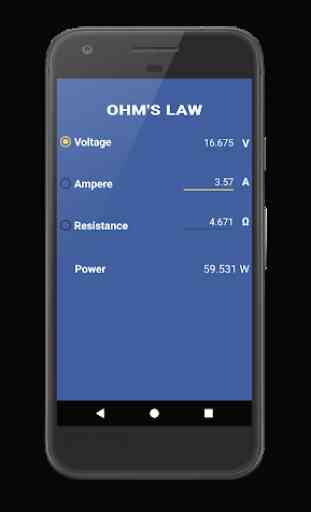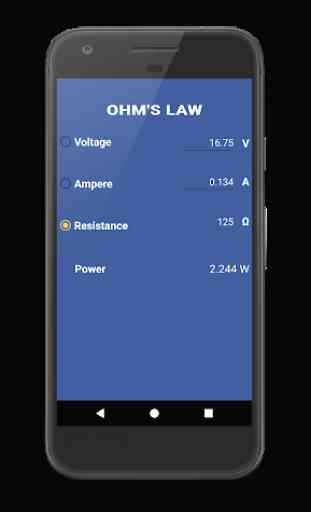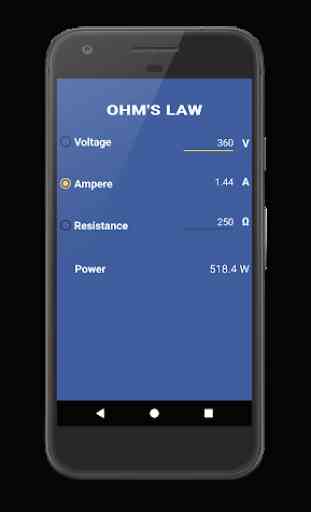Ohm's Law - Electrical Calculator
Ohm's Law - Electrical Calculator instantly calculates voltage, ampere, resistance and power on the fly.
★ FEATURES ★
• Ohm's law calculation in your pocket
• No (special) app permissions
• Calculate the most important electrical sizes
• Instant Voltage calculation
• Instant Ampere calculation
• Instant Resistance calculation
• Instant Power calculation
• Timesaver for electrical professionals
• Helpful calculation tool for college and school
• Automatic convertion to kilo Voltage (kV)
• Automatic convertion to kilo Ampere (kA)
• Automatic convertion to kilo Ohm (kOhm)
• Reliable electrical calculator for students and technicians
• Completly free electrical calculator app
• Easy to use electrical calculator
Ohm's law, in the form above, is an extremely useful equation in the field of electrical/electronic engineering because it describes how voltage, current and resistance are interrelated on a "macroscopic" level, that is, commonly, as circuit elements in an electrical circuit.
> Calculate voltage from resistance and ampere
> Calculate ampere from voltage and resistance
> Calculate resistance from voltage and ampere
> Calculate power from resistance and ampere
> Calculate power from voltage and resistance
> Calculate power from voltage and ampere
Ohm's law states that the current through a conductor between two points is directly proportional to the voltage across the two points. I is the current through the conductor in units of amperes, V is the voltage measured across the conductor in units of volts, and R is the resistance of the conductor in units of ohms. More specifically, Ohm's law states that the R in this relation is constant, independent of the current. The law was named after the German physicist Georg Ohm, who, in a treatise published in 1827, described measurements of applied voltage and current through simple electrical circuits containing various lengths of wire. Ohm's law has been observed on a wide range of length scales. In the early 20th century, it was thought that Ohm's law would fail at the atomic scale, but experiments have not borne out this expectation. As of 2012, researchers have demonstrated that Ohm's law works for silicon wires as small as four atoms wide and one atom high.
- Source: Wikipedia | https://en.wikipedia.org/wiki/Ohm%27s_law
★ FEATURES ★
• Ohm's law calculation in your pocket
• No (special) app permissions
• Calculate the most important electrical sizes
• Instant Voltage calculation
• Instant Ampere calculation
• Instant Resistance calculation
• Instant Power calculation
• Timesaver for electrical professionals
• Helpful calculation tool for college and school
• Automatic convertion to kilo Voltage (kV)
• Automatic convertion to kilo Ampere (kA)
• Automatic convertion to kilo Ohm (kOhm)
• Reliable electrical calculator for students and technicians
• Completly free electrical calculator app
• Easy to use electrical calculator
Ohm's law, in the form above, is an extremely useful equation in the field of electrical/electronic engineering because it describes how voltage, current and resistance are interrelated on a "macroscopic" level, that is, commonly, as circuit elements in an electrical circuit.
> Calculate voltage from resistance and ampere
> Calculate ampere from voltage and resistance
> Calculate resistance from voltage and ampere
> Calculate power from resistance and ampere
> Calculate power from voltage and resistance
> Calculate power from voltage and ampere
Ohm's law states that the current through a conductor between two points is directly proportional to the voltage across the two points. I is the current through the conductor in units of amperes, V is the voltage measured across the conductor in units of volts, and R is the resistance of the conductor in units of ohms. More specifically, Ohm's law states that the R in this relation is constant, independent of the current. The law was named after the German physicist Georg Ohm, who, in a treatise published in 1827, described measurements of applied voltage and current through simple electrical circuits containing various lengths of wire. Ohm's law has been observed on a wide range of length scales. In the early 20th century, it was thought that Ohm's law would fail at the atomic scale, but experiments have not borne out this expectation. As of 2012, researchers have demonstrated that Ohm's law works for silicon wires as small as four atoms wide and one atom high.
- Source: Wikipedia | https://en.wikipedia.org/wiki/Ohm%27s_law
Category : Tools

Related searches




